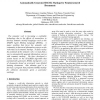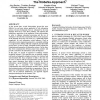AMKM
2003
Springer
14 years 4 months ago
2003
Springer
The semantic web is becoming a realizable technology due to the efforts of researchers to develop semantic markup languages such as the DARPA Agent Markup Language (DAML). A major...
WWW
2003
ACM
14 years 4 months ago
2003
ACM
This article presents the semantic portal MUSEUMFINLAND for publishing heterogeneous museum collections on the Semantic Web. It is shown how museums with their semantically rich a...
WIDM
2003
ACM
14 years 4 months ago
2003
ACM
At the present time, several shortcomings prevent the more effective use and more intense application of web information systems. Recent developments that are subsumed by the term...
SAC
2003
ACM
14 years 4 months ago
2003
ACM
Semantic Web shows us the potential infrastructure of the next generation Web. Web information will be understandable to machines in this infrastructure. Our research work1 has th...
IUI
2003
ACM
14 years 4 months ago
2003
ACM
Computer-based annotation is increasing in popularity as a mechanism for revising documents and sharing comments over the Internet. One reason behind this surge is that viewpoints...
HT
2003
ACM
14 years 4 months ago
2003
ACM
Through scenarios in the popular press and technical papers in the research literature, the promise of the Semantic Web has raised a number of different expectations. These expect...
WISE
2003
Springer
14 years 4 months ago
2003
Springer
At the heart of today’s information-explosion problems are issues involving semantics, mutual understanding, concept matching, and interoperability. Ontologies and the Semantic ...
DEXAW
2003
IEEE
14 years 4 months ago
2003
IEEE
The Semantic Web, also known as the Web of meaning, is considered the new generation of the Web. Its objective is to enable computers and people to work in cooperation. A requisit...
AGP
2003
IEEE
14 years 4 months ago
2003
IEEE
Abstract The Semantic Web (SW) can be seen as abstract representation and exchange of data and metadata. Metadata is given in terms of data mark-up and reference to shared, Web-acc...
SEMWEB
2004
Springer
14 years 4 months ago
2004
Springer
In 1984, Peter Patel-Schneider published a paper [1] entitled Small can be Beautiful in Knowledge Representation in which he advocated for limiting the expressive power of knowledg...


